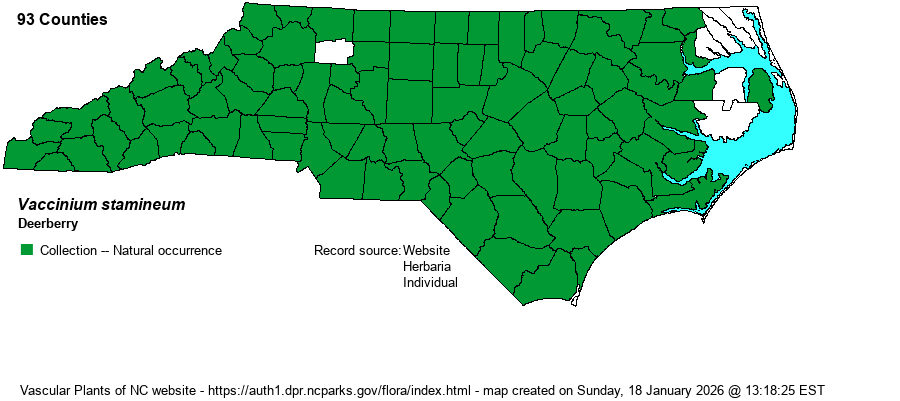| Author | L. | |
| Distribution | Occurs throughout the state, and probably occurs in all counties. It might be absent in a few counties in the northeastern corner of the state, north of Albemarle Sound.
This is a wide-ranging species across the eastern U.S., occurring from VT and NY south to southern FL and eastern TX.
| |
| Abundance | Common and widespread in most areas of the state, but infrequent in the far eastern counties, where absent in a few areas. Not obviously more numerous in one province over another. Though perhaps not as abundant in the state as V. pallidum, this species is certainly the most widespread Vaccinium in the state, in terms of geography and habitats. | |
| Habitat | This a characteristic species of dry to dry-mesic upland woodlands and forests, of many types. It favors pine or pine-oak forests, ranging from sandhills forests to quite rocky and xeric uplands. Unlike most ericaceous species, this Vaccinium can occur on moderately high pH soils, sometimes the only member of the family that can be found in Basic Oak-Hickory Forests and other such woodlands and glades. |
| Phenology | Blooms from April to June, after the leaves have emerged; fruits from August to October. | |
| Identification | This is a fairly low-growing deciduous shrub, ranging variously from 2-10 feet tall, but averaging 4-5 feet tall. (There are quite a few varieties named by some references, partly explaining the disparity in height and some other vegetative characters.) The leaves are elliptical and essentially entire on the margins, growing to about 1.5-2 inches long. They may be a bit glaucous blue-green above and usually are quite pale below. The twigs are usually not yellow-green like V. pallidum, which often grows with it, but are mostly pale green or flesh-colored, but may be gray. However, the flowers are completely different from other ericads in being wide-flaring, very open bell-shaped, white flowers that always dangle downward. When in bloom, therefore, it is easily identified; but when there are no flowers, you may have difficulty putting a name to such an ordinary looking shrub. Though it often grows with several other blueberries and huckleberries, especially V. pallidum, V. tenellum, Gaylussacia baccata, or G. frondosa, it usually does not occur in dense, monoculture stands like these can do. | |
| Taxonomic Comments | Some references list quite a few varieties for this species; Weakley (2018) gives three named varieties and two undescribed varieties just in NC alone. A species-wide revision using DNA data is needed. There are no issues at the species level for V. stamineum, thankfully.
| |
| Other Common Name(s) | Tall Deerberry, Squaw Huckleberry, Highbush Huckleberry, Buckberry, Southern Gooseberry | |
| State Rank | S5 | |
| Global Rank | G5 | |
| State Status | | |
| US Status | | |
| USACE-agcp | FACU link |
| USACE-emp | FACU link |

